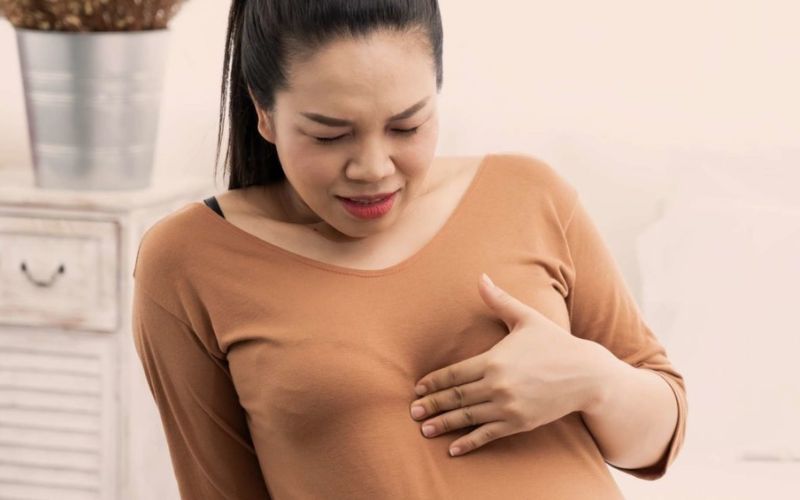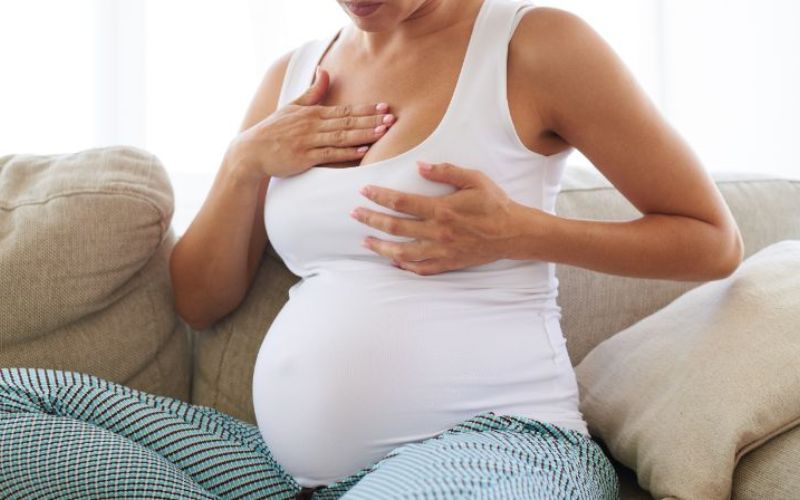The first noticeable sign of pregnancy is often an increase in breast size. This phenomenon is commonly referred to as “pregnancy breasts” in folklore. So, what causes this condition? Let’s find out together!
1 What Are Pregnancy Breasts?
The term “pregnancy breasts” is a folk concept used to describe a pregnant woman’s condition when her breast size increases significantly.
During pregnancy, a woman’s body undergoes hormonal changes, specifically an increase in estrogen and progesterone. These two hormones play a crucial role in the production of breast milk for breastfeeding.
Estrogen stimulates the development of ductal cells in the breasts and the production of prolactin, another hormone. It is this prolactin hormone that causes the breasts to enlarge.
 What Are Pregnancy Breasts?
What Are Pregnancy Breasts?
2 Changes in Breasts During Pregnancy
First Trimester
In the initial stage, a woman’s breasts will experience mild swelling, tenderness, and some pain. They will also feel heavier and fuller.
To meet the growing baby’s needs, there is an increase in blood flow, which causes the veins in the breasts to become more prominent and take on a greenish tint.
The nipples also undergo changes, becoming more sensitive and enlarged. The area around the nipples, known as the areola, darkens and may develop painless bumps.
Second Trimester
A mother’s breasts continue to grow and feel heavier. At this stage, the breasts also start producing colostrum, a nutrient-rich form of milk.
Third Trimester
In the final stage of pregnancy, a woman’s breasts become even heavier and fuller. The nipples enlarge, and the areola becomes darker.
Additionally, the skin may stretch due to the increased size, leading to dryness and itching.
 Changes in Breasts During Pregnancy
Changes in Breasts During Pregnancy
3 Do Pregnant Women with Larger Breasts Produce More Milk?
It is a common misconception that pregnant women with larger breasts will have an abundance of breast milk after giving birth. However, this is not true. The size of a woman’s breasts does not determine the amount of milk she will produce or her ability to breastfeed effectively.
A healthy, nutrient-rich diet and a relaxed mental state after giving birth are far more influential factors in ensuring an ample milk supply.
 Do Pregnant Women with Larger Breasts Produce More Milk?
Do Pregnant Women with Larger Breasts Produce More Milk?
4 What Happens to Breasts After Giving Birth?
After giving birth, a woman’s breasts may continue to grow as they produce milk for breastfeeding. It is only after breastfeeding has ceased and milk production stops that they will gradually return to their pre-pregnancy size.
In some cases, breasts may remain larger and slightly sag, losing some of their elasticity. This outcome depends on various factors, including genetics, weight, and the duration of breastfeeding.
 What Happens to Breasts After Giving Birth?
What Happens to Breasts After Giving Birth?
The term “pregnancy breasts” describes the rapid growth of a pregnant woman’s breasts, which is unrelated to milk production. We hope this information has been helpful!
Source: Marrybaby.vn

































